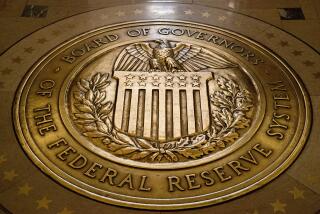Volcker Says Fed Chose to Keep Lid on Interest Rates : He Tells House Panel Credit Won’t Be Tightened Despite Money Supply Surge; M1 Falls $2.2 Billion for Week
- Share via
WASHINGTON — Federal Reserve Chairman Paul A. Volcker has given notice that the nation’s central bank will not be pushing interest rates higher in coming weeks.
Volcker said that, even though a key measure of the money supply is growing much faster than targets set by the central bank, the bank’s policy-makers have decided that such growth would be acceptable.
In a letter to a congressional committee, Volcker said Thursday that the Federal Open Market Committee, the policy-making arm of the central bank, “chose not to move aggressively to tighten (bank) reserve availability to constrain M1 growth.”
Also on Thursday, the Fed reported that the nation’s basic money supply, known as M1, fell $2.2 billion in late October.
M1, a measure of the money supply that includes cash in circulation, checking account deposits and non-bank travelers checks, has been growing well above Fed targets for much of the year and is even above more liberal targets set in June.
Some economists have warned that the surge in money growth carries a risk of rekindling inflation, but other economists contend that the Fed would risk greater dangers if it moved to restrain monetary growth and the corresponding rise in interest rates pushed the country into another recession.
The Open Market Committee, which includes Fed board members and five presidents of regional Federal Reserve banks, met Monday and Tuesday to map strategy.
Volcker’s comments came in a letter to the House domestic monetary policy subcommittee, chaired by Walter Fauntroy, congressional delegate from the District of Columbia.
While Volcker did not specifically mention the Open Market Committee meeting, the fact that the letter was dated Thursday suggested that Volcker had that meeting in mind when he discussed future bank actions.
It is unusual for Volcker or any other official to disclose much about the deliberations of the committee, which meets behind closed doors eight times a year to map monetary strategy, before the minutes of the meeting are made public, something that does not occur for six weeks.
Financial analysts speculated that Volcker’s comments may have been a move to support the actions of the Reagan Administration along with other countries to drive down the value of the dollar.
An expectation of downward pressure on U.S. interest rates would tend to push the dollar lower because it would make investments in America less attractive to foreigners.
Dollar ‘Relatively High’
In his letter, Volcker referred to the “relatively high foreign exchange value of the dollar” as one of the factors the committee weighed in making its decision.
The Administration, working with Japan, Britain, France and West Germany, has been seeking to push the value of the dollar lower since late September in an effort to head off growing protectionist sentiment in Congress.
The high dollar is cited as the chief reason for the country’s expected record $150-billion trade deficit this year as foreign competition has robbed domestic manufacturers of sales.
Most analysts had been predicting a slight rise in M1 for the week ended Oct. 28.
But reaction to the decline was slight in the credit markets, analysts said, partly because of Volcker’s earlier remarks.
Analysts also noted that movement in the money supply had been fairly volatile in recent weeks and that a $2.2-billion drop was not especially sharp.
The Fed said M1 fell to a seasonally adjusted $611.4 billion in the week ended Oct. 28 from $613.6 billion in the previous week.
Some analysts said they believed that the decline reported Thursday was fairly minor in light of the fluctuation of M1 over the past several weeks--including a sharp $8.5-billion increase reported for the previous week--and that market reaction was quiet.
Even with the decline, M1 remained about $8.3 billion over the upper range of the Fed’s growth targets.
More to Read
Inside the business of entertainment
The Wide Shot brings you news, analysis and insights on everything from streaming wars to production — and what it all means for the future.
You may occasionally receive promotional content from the Los Angeles Times.










